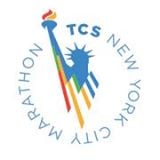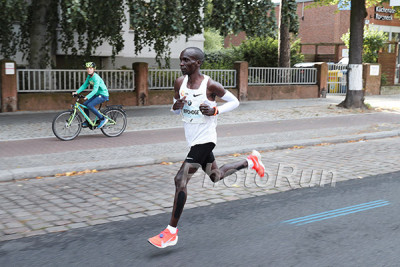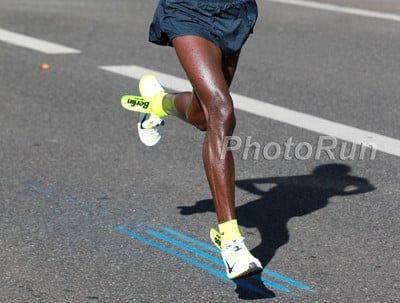It’s Gotta Be The Shoes? Des Linden & Molly Huddle Discuss Nike’s Vaporfly 4% And The Running Shoe Arms Race
By Jonathan Gault
November 2, 2018
NEW YORK — On the first Monday of May, the biggest question in New York is “who are you wearing?” at the Met Gala.
On the first Sunday of November, the biggest question in New York City is very similar: “what are you wearing?” at the New York City Marathon.
Okay, maybe that’s not the biggest question ahead of Sunday’s race, but it’s certainly among them. The more world records fall to Nike’s Vaporfly 4% racing shoes — in the past two months alone, athletes wearing the shoes have broken the men’s world records in the half and full marathon — the more everyone wants to know if the shoes on an athlete’s foot are impacting the results of the race.
Nike introduced the Vaporflys with much fanfare in March 2017 as part of its Breaking2 project, claiming that the shoes offered a four percent increase in efficiency over their previous best marathon shoe. The key component: a carbon fiber plate that acts as a spring to minimize energy expenditure and helps propel runners forward. Athletes wearing the shoes have piled up victory after victory in World Marathon Major events, including four of five on the men’s side in 2018. Four women have broken 2:19 in the marathon in 2018, the most ever in a single year. Three are sponsored by Nike, but the fastest of all of them, Gladys Cherono, wears adidas.
Of course, the athletes wearing the Vaporflys are also pretty incredible. Eliud Kipchoge ran 2:04:00 in 2015 wearing in a pair of Nike shoes that were literally falling apart. Nike athletes win a lot of marathons, but Nike sponsors a lot of good athletes.
“It makes you pause and scratch your head,” says Boston Marathon champion Des Linden, who is sponsored by Brooks. “We’re seeing marathons closed faster than ever before, I really think that. And is that (the shoes) it? I don’t know. There’s a lot of factors it could be, but it’s certainly on the table.”
The other shoe companies have been paying attention. Hoka One One has been developing a shoe with a carbon fiber plate. Linden says that she will race in a prototype of the Brooks Hyperion bonus edition (she also wore a prototype when she won Boston in April), and that her shoe on Sunday will also contain a carbon fiber plate.
“I’m not sure how much I can say, to be honest,” Linden says. “But I think everyone can kind of read into it. There’s obviously an arms race going on right now.”
Molly Huddle, who set the American record in the half marathon earlier this year, will be running in a customized pair of Sauconys (Freedom upper, Type A lower), but they are customized because of her history of foot issues. She has read about the Vaporflys, but doesn’t want to lose sight of the human component.
“It’s a shoe,” Huddle says. “I don’t want to take away from what the athlete is doing. I wouldn’t say that Shalane [Flanagan] didn’t win New York if she didn’t wear Vaporflys because she’s an amazing athlete. I’m not really in the lab…I think if it’s really gonna be like the wetsuits in swimming, it’s either going to be something everyone starts making or it’ll be wiped out of the sport. So I think we’re still kind of in that tipping point to see which way it goes.”
But even the idea that the Vaporflys may offer an advantage not available to everyone can be a source of frustration for athletes.
“I coach Parker Stinson [who runs for Saucony],” says Brad Hudson. “He’s pissed about it every day, trust me. They’re working on their own [shoe], trust me! He lost to [Nike athlete] Chris Derrick by two seconds in the US Half [Marathon Championships]. Okay, he outkicked Parker. Parker’s like, my shoe’s like a moccasin. He’s not making fun of Saucony — Saucony, they make good stuff.”
Hudson also coaches Allie Kieffer, last year’s fifth-placer at the NYC Marathon. Because Kieffer is sponsored by Oiselle, which does not make shoes, she can race in any shoe she wants. So does she wear the Vaporfly?
“Hell yeah she does,” says Hudson. “…I don’t think it’s unfair. The thing is, people choose to be sponsored by a company. Part of the choice is: what do you think of the equipment?”
Hudson also believes that the Vaporflys help some runners more than others, depending on their stride, and that the Vaporfly may not be the best shoe for everybody.
Another question the Vaporflys raise: if a company develops a technology that allows their product to be significantly better than everything else on the market, are they under an obligation to disclose that technology to level the playing field? While the Vaporflys officially debuted in 2017, several Nike pros used a prototype version in 2016, including all three medalists at the Olympics in Rio. Many athletes did not become aware of this until well after the fact.
“I think that the technology’s out there now for the most part and so everyone has a chance to play catch up,” Linden says. “You start rolling back to when it was released and it was very under wraps. Like at the [Olympic] Trials (where Linden was defeated by Amy Cragg, who was wearing a prototype version of the shoe), that’s when the question is, is it fair or not? They have these prototypes [and] we don’t have a ruling on it yet because we didn’t know about it. And then you roll into the Olympics and it’s like very dominant performances by the winners, but they’re also incredible athletes…That’s the question. If you’re going to run in prototypes, do you have to put all the technology out there so that other companies can be on a level playing field? Or do you just keep it hush hush? I don’t know. I don’t know the answer.”
For the record, the IAAF changed its rule governing shoes this year to say: “Any type of shoe used must be reasonably available to all in the spirit of the universality of athletics. Shoes must not be constructed so as to give athletes any unfair assistance or advantage.”
Should a Nike athlete win New York — and there are several athletes who could, including Flanagan, Geoffrey Kamworor, and Vivian Cheruiyot — the questions around Nike’s shoes will only grow more intense. For at least one athlete, however, the recipe for victory in New York remains simple.
“I don’t have them to wear and I don’t need them to win,” Huddle says. “I think you just need to be in really good shape.”
***
Coach Brad Hudson on how the Vaporflys help some runners more than others
Des Linden on how shoe design has become “an arms race”
Molly Huddle doesn’t want to be at the center of a controversy when discussing the Vaporflys



